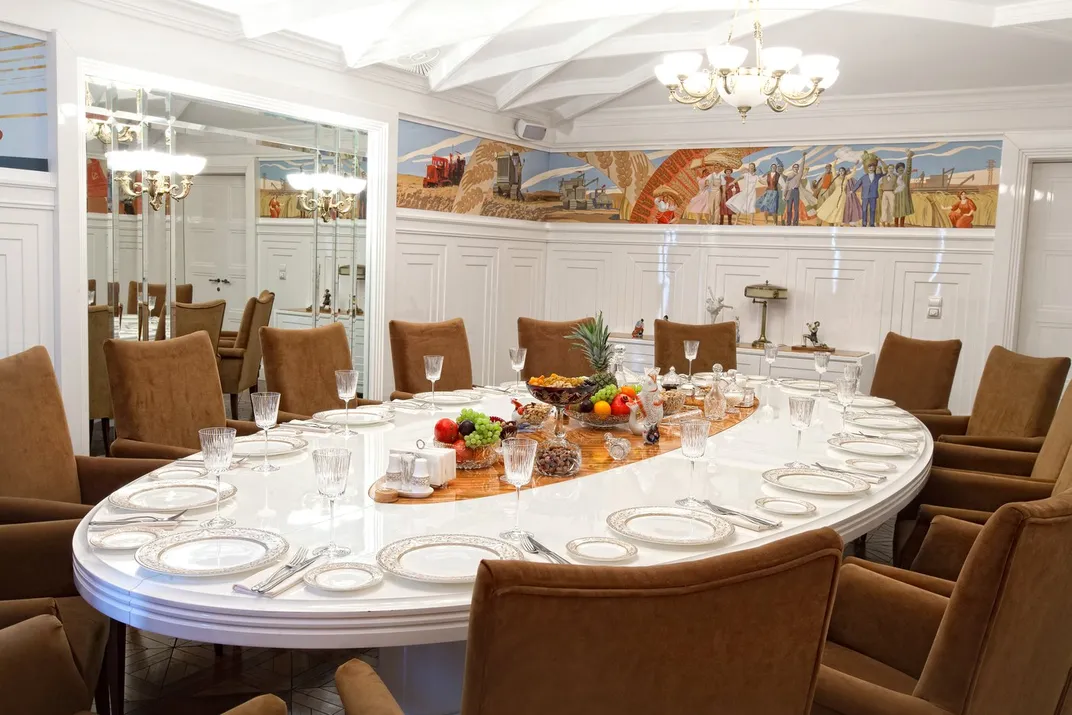The KGB’s Favorite Restaurant Reopens in Moscow
Aragvi, the haunt of Soviet-era celebrities and spies opens after a 13-year absence and $20 million renovation
/https://tf-cmsv2-smithsonianmag-media.s3.amazonaws.com/filer/2e/2a/2e2ae5b2-d740-4bc4-9664-49be1f7172dc/aragvi_exterior.jpg)
Anyone who stepped into Aragvi during the second half of the 20th century was likely to spot a Eastern bloc movie star, chess champion, cosmonaut or a politburo member. For decades, the restaurant at No. 6/2 Tverskaya Ulitsa in Moscow was the place to be seen for the cream of Soviet society and was a favorite haunt of spies and KGB agents. After the fall of the USSR, however, the restaurant fell on hard times and closed. Now, after almost 15 years, the Georgian restaurant has reopened its doors, hoping its Soviet-era cachet will bring it back to the culinary hip list.
Mary Louise Kelly at NPR reports that the restaurant, opened in 1938, was a favorite with Stalin’s chief of secret police, Lavrentiy Beria, who stopped in often with Stalin’s son Vasily for the Georgian wine. It’s even rumored that Beria designed the state-owned restaurant.
Veteran KGB spy Yury Kobaladze tells Kelly that the restaurant was also a favorite haunt of Kim Philby, a British agent secretly working for the Soviets who served as the liaison between MI6 and the CIA. He defected to the USSR in 1963 after being outed as a double agent. “He liked Georgian food,” Kobaladze says. “That's what he told me. He loved Aragvi.”
Many other people also loved Aragvi since, according to Ilya Krol at The Moscow Times, it was the only place in the city to get Georgian cuisine. “You can't compare today’s dining scene in Moscow with the Soviet one,” poet Lev Rubinshtein, who frequented Aragvi in the 1970s tells Krol. “How many places could you get food from the Caucasus in the capital? Just a few places serving shashlik (grilled meat). Aragvi, with its 12-page menu, had no rival.”
Sergei Solovyov, a director known for Assa and Anna Karenina also witnessed the Soviet-era decadence. “I was really shocked when I saw the dishes that you could order there,” he tells Krol. “I can see it as if it were yesterday. They brought our order of lobio, satsivi, shashlik, chicken livers, and caviar to the table … but I was so hungry that I fainted before the waiter brought our plates.”
According to Marina Lapenkova at Agence France-Presse, the formerly state-run restaurant changed hands several times after the fall of the Soviet Union, eventually closing for good in 2003. But the Tashir group and investor Gor Nakhapetyan have spent nearly 15 years and $20 million to restore the nine-room restaurant. The main dining rooms are painted with Soviet murals depicting tractors, workers and sheaves of corn, but otherwise the space does not resemble the previous incarnation.
Head chef Alexei Zenin tells Krol that the menu focuses on authentic versions of Black Sea cuisine, like the dumpling khinkali and the chopped salad pkhali. Unlike the first time around, the restaurant faces stiff competition. Cheap Georgian food has become very popular in Moscow. That’s why the owners hope to capitalize on the restaurant’s unique history.
But recreating the Cold War ambience exactly would be difficult. Mikhail Lyubimov, a former KGB agent who headed operations against Britain and Scandinavian says most of the staff at the restaurant were retired KGB officers and the restaurant was a great recruiting ground for spies. It was also the spot where agents held farewell parties for colleagues going abroad. He tells Lapenkova he remembers a night “with plenty of drinking, [when] one of our men invited a beautiful woman to dance, not realizing she herself was a US spy and was being tailed by the KGB.”
To get the mood just right, the restaurant would have to bring back the surveillance too. “Everything was bugged, you know?” Kobaladze tells Kelly. “But everybody knew that if you were in Aragvi: don’t talk, keep quiet. The rumor was that all [the] tables had microphones.”
